
CLEAN SWEEP: The Roomba, a now ubiquitous floor-cleaning robot, is perhaps the biggest success story to come from the SBIR program—but it lacks practical application in a military setting. (Photo by Getty Images)
The AAL’s four tenets for businesses wanting to work in the Army’s “four-letter word” program—SBIR.
by Dr. Casey Perley, Scott Stanford, Stephanie Hill and Joshua Israel
For years, Congress and the defense establishment have sought a better return on investment (ROI) from the Small Business Innovation Research (SBIR) program, both for the DOD and for companies on SBIR contracts. The Army SBIR program is designed to provide small, high-tech businesses the opportunity to propose innovative research and development solutions to critical Army needs. The return to great power competition has increased the stakes beyond ROI.
In recent testimony, Barbara McQuiston, then the official performing the duties of the undersecretary of defense for research and engineering, said of SBIR, “We have to be able to work at the speed of commercial flexibility because we don’t want to just be able to understand what their technology is, we need to be able to capitalize on it and field these systems for the warfighter” (emphasis added). McQuiston, who launched a DOD innovation steering group in April, added that “we have to move at speeds that are within a commercial timeframe.”
Congress and senior Pentagon officials, including Deputy Secretary of Defense Dr. Kathleen Hicks, who directed the formation of the steering group, are eager for SBIR to result in fielded capabilities. Rep. Ken Calvert, R-Calif., has even proposed legislation requiring service secretaries to identify promising SBIR technologies for inclusion in future budgets. For SBIR to be successful, though, changes must be made at the base of the pyramid, far below service secretaries, about what technologies enter the program and how they will contribute to DOD priorities.
The Army SBIR program distributes more than $300 million a year in contracts to U.S.-based small businesses; the other services across the DOD distribute hundreds of millions more. Yet despite this, the biggest DOD SBIR success story in its 40-year existence is perhaps putting the Roomba under the cat in your living room—a viable technology, but with no application to DOD needs. SBIR is not tied to a specific budget activity code, and unlike programs of record, SBIR projects do not need to be laid out in the Congressional budget years before a program manager even knows if a technology can contribute to her or his program.
SBIR does not measure the outcomes of the programs it funds—whether there has actually been “innovation”—but rather the number of those programs. But SBIR can be a very potent innovation and modernization tool, and the Army Applications Laboratory’s (AAL) Special Program Awards for Required Technology Needs (SPARTN) program has proven how. AAL, a subordinate of Army Futures Command, discovers and delivers current and emerging technologies and applies innovation best practices to warfighter needs.
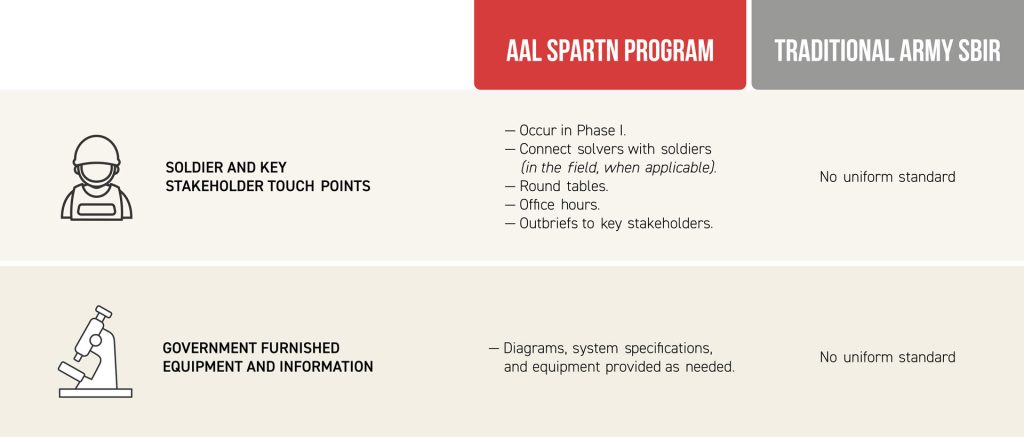
TOUCHDOWN: SPARTN puts an emphasis on early feedback and hands-on experience by Soldiers, and provides businesses with access to relevant government information. (Graphic by AAL)
SPARTN has done this for SBIR. SPARTN has reduced application requirements by 50 percent for businesses wishing to participate, has increased cash paid to small businesses, and cut award notification and contract timelines by 78 percent.
A year and a half since SPARTN’s launch, eight solicitations (commonly called topics) are in, or are just exiting, the contracting stage, and five more will follow in the coming months. These topics represent the specific technology needs of six cross-functional teams and seven program managers, many of whom hadn’t considered using SBIR to solve their problems before SPARTN.
DELIVERING VALUE
Before SPARTN and other initiatives to update the program such as at the newly-formed Applied SBIR office in ASA(ALT), SBIR appealed mainly to a small handful of companies that had cracked the code on how to win contracts through the program.
A shocking statistic to illustrate this point: nine companies have combined to win more than $2.5 billion in SBIR contracts. The small businesses the Army hopes will help solve its modernization technology needs have not been participating, and inertia in the SBIR program has resulted in an institutionalized preference for companies set up to win SBIR contracts irrespective of whether or not those contracts result in value to the government.
In addition, capital moves too slowly in the Army SBIR program, making it a risky proposition for small businesses with limited financial runways. It would take 8.5 months on average, from the submission of a proposal until a business received the first payment. Real innovators, the kind the DOD needs to help fill its capability gaps, will not wait this long to get paid. In fact, they cannot. And investors have been clear that a program with these characteristics is not a realistic opportunity, and they have steered promising companies away from it.
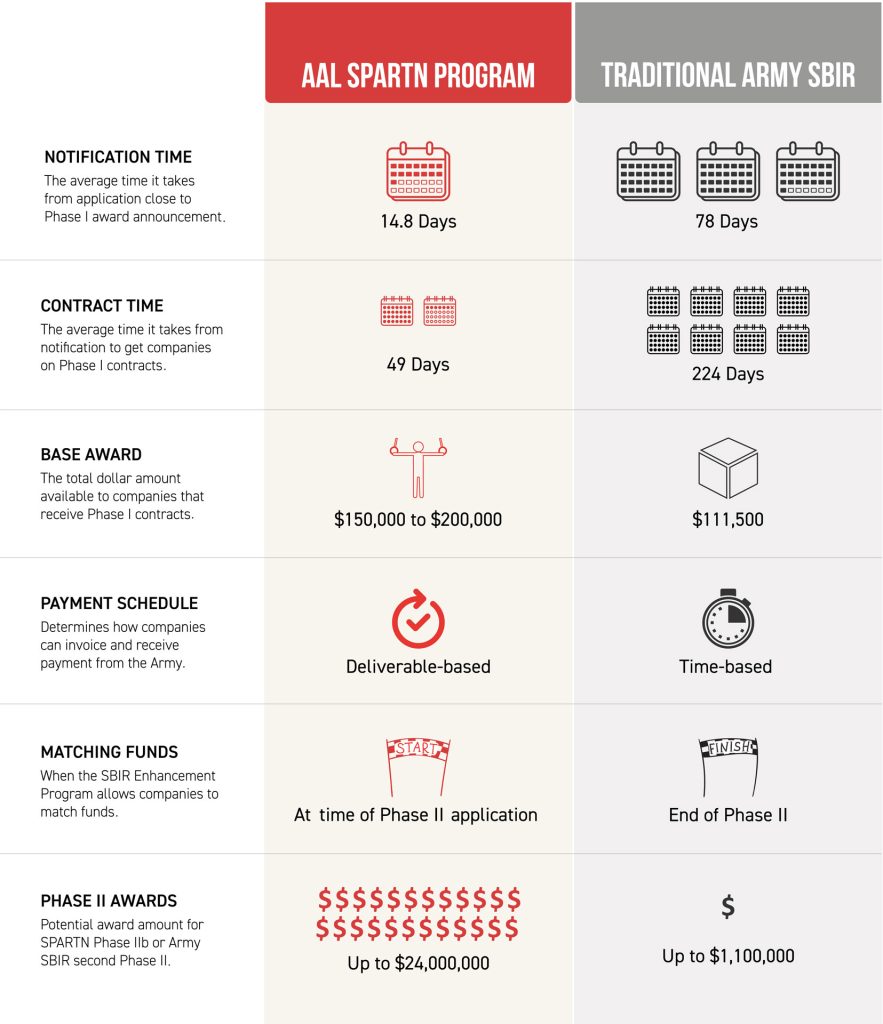
COMPARE AND CONTRAST: The SPARTN program has shortened timelines and enhanced funding opportunities, creating measurable improvements over the traditional SBIR program. (Graphic by AAL)
It isn’t only a challenge for businesses. The Army cannot accept administrative inertia in a program it uses to fill critical modernization technology gaps. It can take more than 14 months from the time Army stakeholders propose a SBIR topic until a contract is signed to begin work solving an Army problem. Entire technologies can come and go in the time it took SBIR to produce nothing more than a contract.
AAL started with a simple question: What do companies need from the Army to make it an appealing market for commercial solution providers? The answer has enabled SPARTN to rewrite the SBIR playbook to make the Army a better business partner for small technology firms.
AAL gleaned the answers through extensive, direct engagement with businesses, investors, accelerators, aggregators and other parts of the commercial tech ecosystem. While the difficulties they expressed apply broadly to DOD as a business partner, SPARTN was able to address them in the SBIR program largely by removing self-imposed restrictions. None required changes in laws or authorities.
The four key tenets to make the Army a viable business partner are:
- Potential for long-term revenue and long-term relationships.
- A level playing field for companies who don’t regularly work with DOD.
- Sufficient capital moved at the speed of business.
- Access to government-furnished information, key stakeholders and users.
These tenets not only represent what companies need when doing business with the DOD, providing these basics also enables and incentivizes companies to create better solutions to Army modernization challenges. Consequently, some Army stakeholders who used to view SBIR as a four-letter word are beginning to use it to solve some of their most vexing technical problems.
LONG-TERM REVENUE AND RELATIONSHIPS
SPARTN topics offer only two paths for companies on contract: transition to follow-on contracts or early off-ramp of technologies without transition potential. It eliminates the third option: a limbo in which companies wait, and hope, for funding as a program of record or part of one.
AAL works with cross-functional teams (CFTs) and program managers to identify and frame SPARTN problems important to them and to the Army. No SPARTN topic has ever been released without personal endorsements from both the CFT director and the program manager. Their endorsement is a pledge to be involved in the entire process, from problem framing and company selection through to transition or off-ramp, ensuring the right people make decisions on technology investments and companies have continuous access to the problem and to problem owners.
AAL gains insight into their acquisition timelines and can tailor timelines and funding under contracts accordingly. Traditional Army SBIR has used a one-size-fits-all Phase I contract in which the funding amount and a three-year timeline for development through prototype are set from the start. SPARTN’s technology-specific funding and flexible periods of performance enable stakeholders to plan for funding continuity so technologies do not sit in limbo for two or three years waiting to be included in the POM—the “valley of death.”
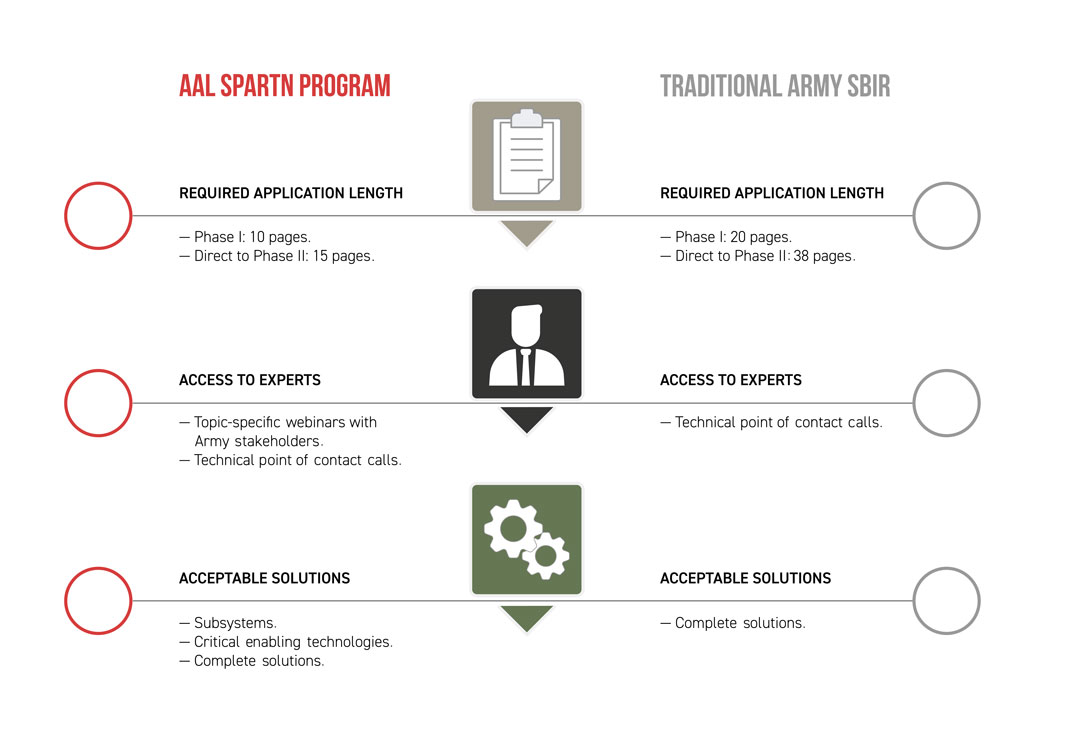
BARRIERS TO ENTRY: By reducing the paperwork burden, providing more practicable information from experts and allowing a wider array of proposed solutions, SPARTN makes it easier for companies to do business with the Army. (Graphic by AAL)
LEVEL PLAYING FIELD
SPARTN topics receive an average of four times as many applications as traditional Army SBIR, according to data from the Office of the Secretary of Defense SBIR portal. Outreach for the program happens across a range of digital channels, including Instagram, LinkedIn and Twitter. This outreach emphasizes the problem to be solved—allowing solvers to understand where their company fits into the Army’s needs—rather than discussing how the SBIR program works, as the Army SBIR website had done before its favorable redesign in July. When AAL increases commercial awareness of Army problems and provides resources specifically to help companies through the application process, it matters.
Another reason SPARTN applications are way up is that AAL rewrote SBIR application requirements, simplifying the language and decreasing the technical application length by more than 50 percent. If a company doesn’t apply for a SPARTN topic, it should be because its technology isn’t relevant, not because life is too short to go through the process.
AAL presumes that companies interested in working with the Army have no knowledge of Army structures or systems. SPARTN problems are broad, presented in plain language, devoid of jargon and designed to allow commercial problem solvers to propose solutions the Army hasn’t thought of yet. The difference between “build an autoloader for field artillery” and “how can we make field artillery fire faster” creates a world of potential solutions. Companies can attend webinars where technical specifications and application requirements are laid out and complex military processes are explained by experts.
As a result, SPARTN portfolio companies with little prior DOD experience were nearly five times more likely to receive follow-on awards than companies whose primary business was SBIR. More companies now see the Army as an attractive and approachable business partner: 44 percent of SPARTN portfolio companies were new to their Army stakeholders and 93 percent of applicants would recommend SPARTN to colleagues, as measured by AAL’s net promoter score surveys.
|
CONTRACTS AND CAPITAL The Army’s Small Business Innovation Research (SBIR) program follows a generic and prescriptive process that gets companies on contract an average of 224 days from the time they submit their proposals. This rigid structure makes the program easy to manage but it is not efficient for companies or for Army stakeholders. The Army Applications Laboratory’s (AAL) Special Program Awards for Required Technology Needs (SPARTN) program is the only Army SBIR program to tailor base contract award amounts specific to each topic. The funding amount is derived through tailored base contracts, the SBIR enhancement program, high-dollar value Phase IIb contracts and faster contracting speeds. AAL identifies where commercial technology is mature enough to skip the standard proof-of-concept contract stage, and allows companies to enter the program on higher value Phase II prototyping contracts. SPARTN can also award different companies Phase I and Phase II contracts simultaneously for the same topic, which allows the Army to pursue the most promising technologies for a program when companies have relevant solutions at different maturity levels. Traditional Army SBIR did neither of these, making companies apply for Phase I and then Phase II contracts regardless of the maturity of the technology. SPARTN is also the only Army program that offers SBIR Phase IIb awards. These contracts are a cost-sharing measure between industry and the Army that drive down the Army’s development costs. Companies use matching funds—both from the PM and the company—for a contract of up to $24,000,000 total value. This additional funding can accelerate project delivery timelines and help companies develop technology to a higher maturity level or add beneficial features. The SBIR enhancement program will match an equivalent investment from a company of up to $500,000 for promising technologies. Historically, this match is activated toward the end of Phase II prototype development. SPARTN activates matching funds at the time of application for Phase II, which opens the door to getting more features or a more mature solution faster through an injection of more capital. About 30 percent of eligible SPARTN companies have exercised the option, pouring $1.5 million in private cash contributions into Army modernization in just three months—roughly 80 percent of Army SBIR’s yearly average for companies’ cash contributions. While these capital incentives are attractive, companies will remain skeptical of SBIR opportunities if the Army cannot pay them on commercially acceptable timelines. For all SPARTN topics, review timelines were cut from an average of 78 days to 14.8 days. SPARTN also gets companies on contract quickly. The 224-day average from solicitation close to contract award for Army SBIR is 48 days on average for SPARTN. SPARTN puts money in the hands of companies two to three times faster by using deliverable-based, rather than time-based, contracts and making the initial deliverable due very early in the contract. SPARTN pays up to half the contract value in the second week, while SBIR pays one sixth of the contract on rigid timelines. With SPARTN, small businesses don’t pay out of pocket to work with the Army. |
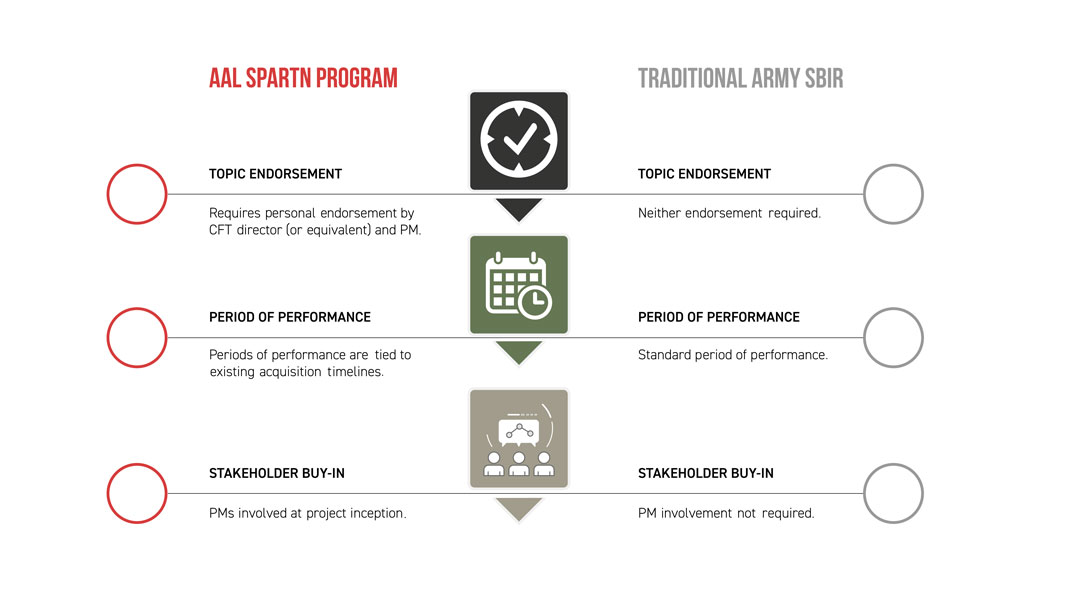
TOP COVER: The SPARTN program links its topics directly to CFT and program manager needs and involves stakeholders throughout the process so that outcomes will be more beneficial to DOD. (Graphic by AAL)OPEN ACCESS
Problem solvers must understand the problem intimately, and that requires a close relationship between solvers, scientists and Soldiers. It also requires that companies have access to critical information about the problem, like engineering specifications. First-hand experience helps companies adjust their concepts and prototypes to incorporate newly-discovered insights.
SPARTN always includes a range of Army stakeholders and experts such as requirements writers, scientists, engineers, and capability development integration directorates who contribute expertise and capture lessons learned in SPARTN’s holistic project management approach. This ensures the Army doesn’t waste taxpayer money repeating mistakes or building requirements for “unobtainium” by neglecting to learn from technologies that didn’t pan out.
SPARTN IN ACTION: The Fire Faster Cohort is an example of applying the AAL model to SBIR with SPARTN. Fire Faster supports Product Manager Self-Propelled Howitzer Systems and the Long Range Precision Fires Cross Functional Team. It is part of an ACAT-1 program, one of the most significant programs in the Army, reflecting the potential of a business-relevant SBIR program
Fifteen small businesses were selected for Phase I contracts to develop proofs of concept for novel solutions to increase the rate of fire of the M109 Paladin self-propelled howitzer system. They were asked to apply their own expertise and creativity to the problem, and were not given a thick requirements document for a predetermined solution.
Just 18 weeks and $3 million resulted in five concepts that graduated to Phase II—a clear improvement in cost and schedule. Of the five, four are complementary systems conceived by experts in the cutting-edge technologies on which they are built. Product Manager Self-Propelled Howitzer Systems has the option of modularity with the four, and can adjust their acquisition based on the maturity of the tech, funds available, or other considerations. This also mitigates the risk to the program, and to the Army, of buying one solution that ultimately proves unsatisfactory.
Among the Phase II concepts are solutions the CFT and the product manager never considered—another benefit derived from letting the innovators access the problem in depth. And every Phase I concept changed after the problem solvers went to the field to work first-hand in the Paladin with Soldiers and the product manager.
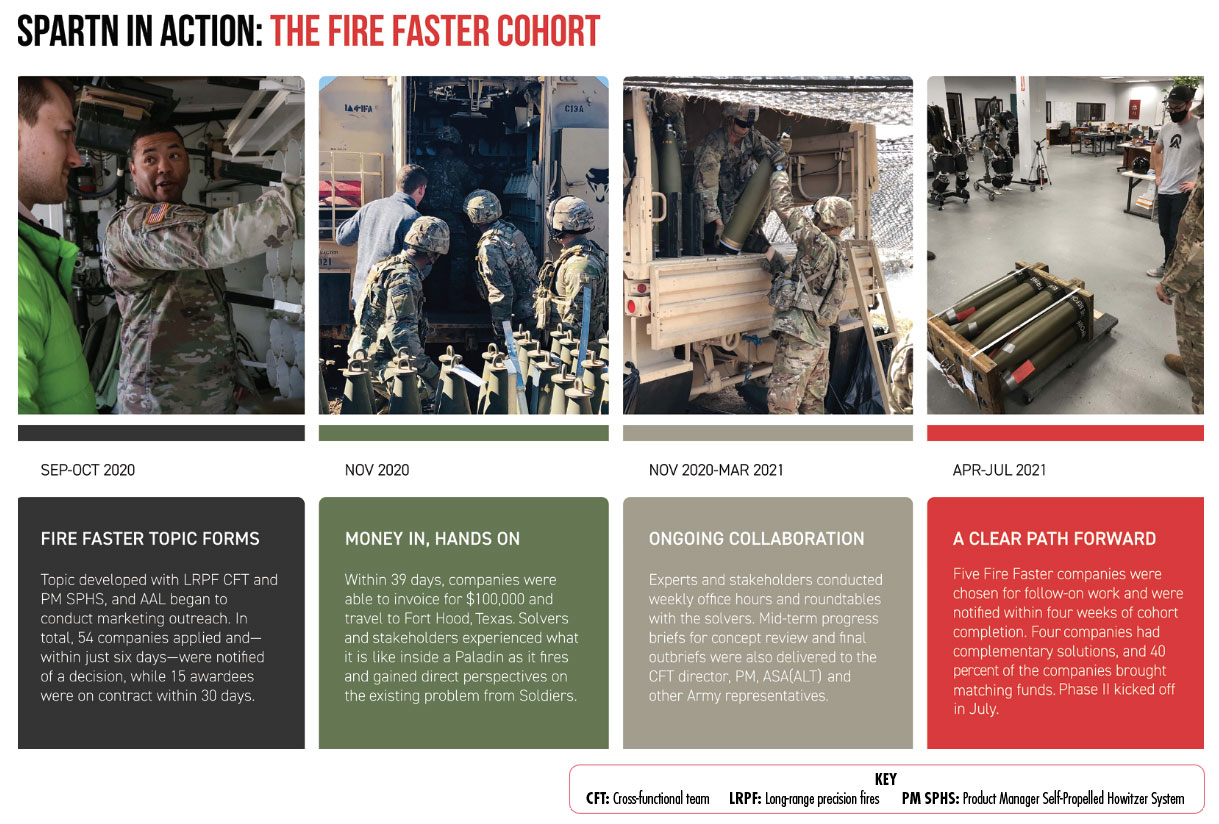
CASE IN POINT: The Fire Faster Cohort was a pilot SPARTN effort to leverage small businesses to increase the rate of fire of self-propelled howitzer systems. (Graphic by AAL)
CONCLUSION
There are hundreds, maybe thousands, of companies with no history of working with the government that can help solve Army problems. The Army must make it worth their time and effort. SPARTN demonstrates that SBIR can be a viable entry point for small businesses and a powerful tool to fill critical modernization gaps while reducing costs and accelerating transition.
If Army modernization is to succeed, the service must standardize successful methods, its messaging about them, and metrics that prove ROI rather than money spent. It must reinforce success and ensure that lessons are learned rather than missteps repeated. To do otherwise would be a broken promise to nontraditional DOD partners and would turn back hard-earned and badly-needed progress. It will be harder to convince businesses again.
For more information, go to https://armyfuturescommand.com/aal/.
CASEY PERLEY is the director of insights and analysis for the Army Applications Laboratory, and helped establish the SPARTN program. She holds a Ph.D. in molecular genetics and microbiology from Duke University and a B.S. in molecular biochemistry and biophysics from Yale University She has over a decade of experience studying infectious diseases that threaten U.S. Soldiers and the public, and has spent over 3,000 hours working in high containment facilities (biosafety levels 3 and 4).
SCOTT STANFORD is the director of communications and strategy for the Army Applications Laboratory and a lieutenant colonel in the Vermont Army National Guard. He holds an M.A. in international relations from the Fletcher School of Law and Diplomacy at Tufts University and a B.A. from the University of Texas at Austin. His communications experience spans 30 years in print and TV journalism, public relations, and information operations. He has deployed to Iraq, Afghanistan, and the east and west coasts of Africa as an infantryman and a civil affairs officer.
STEPHANIE HILL is a knowledge integrator and team optimizer committed to modernizing the government and DOD through proven ability to conceive and implement strategy, apply digital technologies, secure stakeholder buy-in, and communicate vision as a trusted business partner and adviser. She currently works at GXM Consulting, supporting Army Futures Command leaders with major strategic initiatives. She holds a B.A. from Georgetown University and is pursuing an M.A. in government counter-terrorism and homeland security studies at the Interdisciplinary Center in Herzliya, Israel.
JOSHUA ISRAEL is an Army civilian and was the Army Applications Laboratory Strategic Partnership lead helping establish SPARTN. He has held leadership positions in government and industry, including engineering expert, acquisition manager, and business and financial management director. He holds an M.S. in national resource strategy from National Defense University, an MBA from New York University’s Leonard N. Stern School of Business, an M.S. in engineering management from the University of Maryland, Baltimore County and a B.S. in chemical engineering from Virginia Tech.







